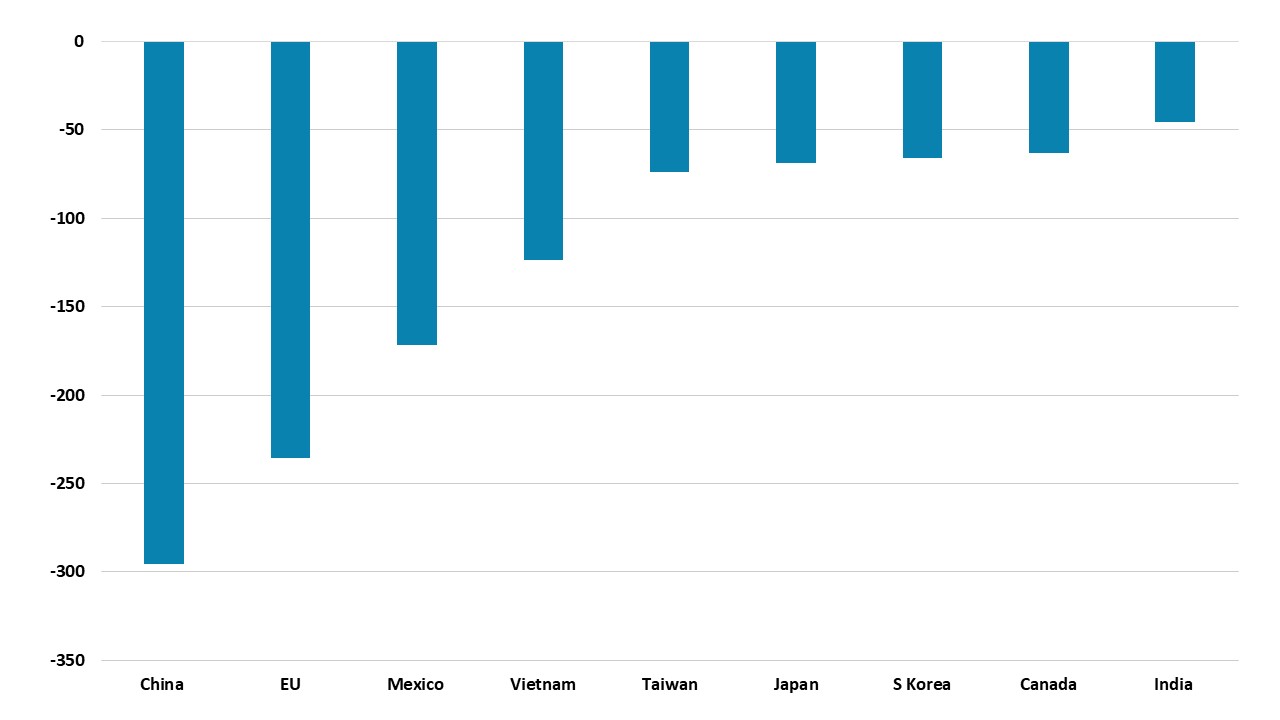Trump Latest Thinking
Bottom line: President Donald Trump signaled that he is committed to tariffs to raise revenue; bring production back to the U.S. and get fairer trade relations. This three part approach will likely shape implementation of further product and reciprocal tariffs from April. However, reports suggesting that the Canada/Mexico tariff could be reduced, which suggest that market pain could have an impact on the magnitude of future tariffs. Meanwhile, Trump also indicated that Ukraine president was read to move to peace negotiations, though progress to a peace deal will still remain tricky as any amended Russia demands are not yet clear.
Figure 1: U.S. 2024 Bilateral Trade Position (USD Blns)

Source: BEA/Continuum Economics
Key points from Trump speech to Congress and their ramifications include
· 3 part approach to tariffs. Trump made clear that his strategic thinking on tariff remains that they can raise revenue; can shift production back to the U.S. and can get better trade with bilateral partners. The decision this year have been more aggressive than expected with the 25% Canada and Mexico across the board tariffs on the pretext of immigration and fentanyl – but hints from the U.S. commerce secretary that the USMCA review is also in focus. Trump did admit that the tariffs will cause a little disturbance, but the reality will be moderate hit to U.S. growth and boost to CPI inflation if the Canada/Mexico tariffs are kept at 25%. U.S. businesses will find it difficult to boost production quickly and this means that tariffs will feed more into inflation and in turn hit spending and GDP. Additionally, U.S./Canada/Mexico supply chains are very integrated in some sectors e.g. autos and the tariffs could like makes this more complex and slow production in all three countries. Finally, the communications on tariff is volatile and causing confusion with delays; then last minute go ahead and now potential relief. This all risks hurt business sentiment.
· Market warning and relief. The U.S. equity market react to the Canada/Mexico tariffs with a selloff, given the prospect of a modest to moderate hit to the U.S. economy. U.S. commerce secretary then hinted at some relief for Canada/Mexico somewhere in the middle and as soon as Wednesday. Whether the equity market selloff caused Trump apparent softening on 25% tariffs is unclear, but under Trump 1.0 he was sensitive to equity market declines. However, if the equity market declines go too far, then the risk is that Trump will call on the Fed to cut rates immediately. We will have to see what relief looks like for Canada/Mexico, though Lutnick was clear that China will not get any relief on the extra 10%. The U.S. appears to want to put maximum trade pressure on China in the 1 half of 2025.
· S Korea/India and EU. Trump highlighted his concerns about relative tariffs between S Korea and the U.S., while also mentioning India again. Trump is clear that friend or foe will end up in bilateral discussion on how to reduce the U.S. bilateral trade deficit (Figure 1). April is due to see announcement on product (car/semiconductors/pharm/lumber – expected at 25%) plus reciprocal tariffs. These will be used to get better trade deals, but in Trump’s 3 part approach also to shift production back to the U.S. and raise revenue. Some of the tariffs will be permanent. Trump strong dislike of the EU/Germany suggest they will be a major target in the spring.
· Ukraine. Trump indicated that he had received a letter from Ukraine president signaling that Ukraine was ready to negotiate a peace deal and reopens the way to the U.S./Ukraine mineral deal. Whether this led to a 2 Trump/Zelensky meeting remains to be seen. More importantly, the next major step is U.S./Russia negotiations and what terms Russia would consider vital for a peace deal. Russia is unlikely to give up on no NATO membership for Ukraine, but could have limited flexibility on what occupied land in Ukraine are kept by Russia. Meanwhile, despite Trump saying that Putin is willing to have European peace keeping troops in Ukraine, the Kremlin has subsequently clarified that Russia position remains no European peace keepers in Ukraine (here). Putin might argue that it has to be under a UN umbrella without European forces, which would be a weak security guarantee as this would have a more limited rules of engagement than a European peacekeeping or reassurance force in Ukraine. Alternatively, he could argue that no foreign troops should not be in Ukraine and argue that Ukraine needs to be a neutral country and reduce the size of its armed forces as a precondition for peace. Russia could concede some land and then the U.S. comes back to Ukraine to tell them Russia terms!